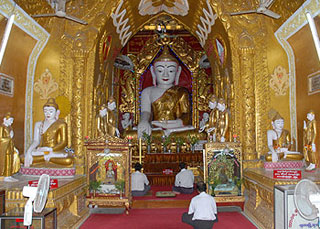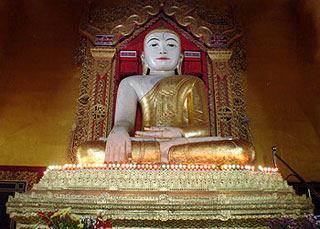Amarapura lies on the left bank of the Ayarwaddy River. A suburb of Mandalay. it is also known as Taung-myo (Southern Town) or Myohaung (Old City). Founded by King Bodawpaya in 1783 as his new capital. Amarapura means City of Immortality. Amarapura was the capital city of Myanmar. during the Konbaung Dynasty. It was founded by King Bodawpaya in 1782 AD. as the king transferred the capital from Innwa (or Ava). King Bagyidaw. grandson of Bodawpaya shifted the capital back to Innwa in 1823. but King Tharrawaddy his successor again took the capital back to Amarapura in 1837 and it remained as the capital until King Mindon built Mandalay in 1857 and shifted the capital there in 1860.
About Amarapura
Visitors to Amarapura can still see the tombs of King Bodawpaya who died there on 5th June 1819. located to the north of Shwezaga Pagoda. and also of King Bagyidaw. located east of Pyatthat Gyi Village . King Bagyidaw died in Amarapura on 15th October 1846 after being de-throned in 1837. These two white washed brick mausoleums have inscriptions in English and Myanmar. They are actually small chedis (pagodas) enshrining the cremated bones of the two famous kings. There is another smaller chedi enshrining the bones of King Tharrawaddy who died in Amarapura on 17th November 1846. This is located to the north of the palace site close to the present family lines of the 3rd Battalion. Electrical and Mechanical Engineersl Corps II. Tourists can ask the local people to guide them to these mausoleums.
Amarapura is famous for the Silk Weaving Industry. Most of the Myanmar people are very proud to attend the cultural ceremonies with Achiek Longyi. mainly produced from Amarapura. Not very far from Mandalay city and accessible by car.
Click here to see the Map of Amarapura
Interesting Places
U BEIN BRIDGE
U Bein Bridge is about three quarter of a mile. crossing the Taung-tha-man Inn (lake). It is one of the most attractive spot for tourists. It is the longest teak bridge in the world and is about two centuries old.
This bridge became to be known as U Bein Bridge after the name of the donor. U Bein who was a clerk to the Mayor of Amarapura. It was constructed in 1849 from old planks and timber posts of dismantled houses in Sagaing and Inwa. It took nearly two years to finish. but since it was opened in 1851 it has constantly been in use by the people and in recent years by foreign visitors also. There are now 1086 posts and 482 spans. At 9 points. were what served as drawbridges which were built to allow the royal barges and war boats to go under the bridge and out to the Ayeyarwadi River in the old days.
KYAUKTAWGYI PAGODA
The Kyauktawgyi Pagoda was built by King Bagan in 1847 on the model of the Ananda Temple at Bagan.
It closely resembles the Ananda in exterior form but it falls short of the latter in construction and interior decoration. Unlike the Ananda. which has perfect vaulted roofs. the Kyauktawgyi has wooden rafters and beams. which account for the weakness of the structure. There is one principal image carved out of a single block of Sagyin marble. The walls in the east and south porches are adorned with paintings depicting many religious buildings erected by the donor and other kings in different parts of the country. and scenes from contemporary Burmese life.
PAHTODAWGYI PAGODA
In the southern part of Amarapura. the Pahtodawgyi Pagoda modeled on the Mahazedi of Sri Lanka. The foundation of this pagoda was laid by King Bagyidaw and his Queen on 2nd March 1820. The pagoda was completed on 19th February 1824. The base measures 180 feet in circumference. and the height also measures 180 feet. The official title of the pagoda is Maha Vijayaramsi. This well preserved pagoda stood outside the old city walls. The lower terraces have marble slabs illustrating scenes from the Jataka. You’ll have a fine view over the surrounding countryside from the upper terrace. An inscription stone. within the temple precincts. details the history of the pagoda’s construction.
SHWE GU GYI PAGODA


Located on the west of the railways compound and between wards Zay Cho and Hman Dan. there is a temple called Shwe Gu Gyi (Golden Big Cave). One contemporary inscritpiton found at the cave temple mentioned that the ruin left by King Narapati Sithu (AD 1174) was repaired by the Crwon Prince (Sirimahadhammabhidhaja Sihasura) who held Shwe Daung and Dapayin in fief and his consort (Siri Tilakamaha Subbadda ratanadevi) in the time of King Badon (1782-1819). The repairs were completed in Sakkaraj 1145 (AD 1783). For the maintenance of the pagoda. the religious land is given. In area it measures 820 pe. For keeping the pagoda precincts clean and for doing necessary repairs from time to time 63 workers (male and female) are also given. The height of the whole edifice is 90 feet. For stucco carvings of Amarapura as an exteriro decoration one has to study them. On the south of the Shwe Gu Gyi there is Shwe Gu Tha which is also a cave temple but it has the best for paintings for interiro decoration. Both temples are under the care of the Archaeological Department.
MAHAR WAI YAN BON THAR BARGAYA MONASTERY


PALACE RUINS
Little remains of the old Amarapura palace but you can still find two masonry buildings — the treasury building and the old watchtower. King Bagyidaw and King Bodawpaya were both buried here and their tombs also remain. The corner pagodas still stand at the four corners of the once square city.









